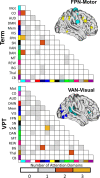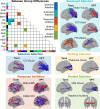Functional Connectivity Network Disruption Underlies Domain-Specific Impairments in Attention for Children Born Very Preterm
- PMID: 33067997
- PMCID: PMC8179512
- DOI: 10.1093/cercor/bhaa303
Functional Connectivity Network Disruption Underlies Domain-Specific Impairments in Attention for Children Born Very Preterm
Abstract
Attention problems are common in school-age children born very preterm (VPT; < 32 weeks gestational age), but the contribution of aberrant functional brain connectivity to these problems is not known. As part of a prospective longitudinal study, brain functional connectivity (fc) was assessed alongside behavioral measures of selective, sustained, and executive attention in 58 VPT and 65 full-term (FT) born children at corrected-age 12 years. VPT children had poorer sustained, shifting, and divided attention than FT children. Within the VPT group, poorer attention scores were associated with between-network connectivity in ventral attention, visual, and subcortical networks, whereas between-network connectivity in the frontoparietal, cingulo-opercular, dorsal attention, salience and motor networks was associated with attention functioning in FT children. Network-level differences were also evident between VPT and FT children in specific attention domains. Findings contribute to our understanding of fc networks that potentially underlie typical attention development and suggest an alternative network architecture may help support attention in VPT children.
Keywords: attention; functional connectivity; networks; outcome; preterm.
© The Author(s) 2020. Published by Oxford University Press. All rights reserved. For permissions, please e-mail: journals.permissions@oup.com.
Figures




Similar articles
-
Altered functional network connectivity relates to motor development in children born very preterm.Neuroimage. 2018 Dec;183:574-583. doi: 10.1016/j.neuroimage.2018.08.051. Epub 2018 Aug 23. Neuroimage. 2018. PMID: 30144569 Free PMC article.
-
Preterm birth leads to impaired rich-club organization and fronto-paralimbic/limbic structural connectivity in newborns.Neuroimage. 2021 Jan 15;225:117440. doi: 10.1016/j.neuroimage.2020.117440. Epub 2020 Oct 8. Neuroimage. 2021. PMID: 33039621
-
Altered resting-state functional connectivity in children and adolescents born very preterm short title.Neuroimage Clin. 2018;20:1148-1156. doi: 10.1016/j.nicl.2018.10.002. Epub 2018 Oct 3. Neuroimage Clin. 2018. PMID: 30388598 Free PMC article.
-
Connectivity.Curr Top Behav Neurosci. 2014;16:49-77. doi: 10.1007/7854_2013_244. Curr Top Behav Neurosci. 2014. PMID: 23943564 Review.
-
Neuroimaging of brain connectivity related to reading outcomes in children born preterm: A critical narrative review.Front Pediatr. 2023 Mar 1;11:1083364. doi: 10.3389/fped.2023.1083364. eCollection 2023. Front Pediatr. 2023. PMID: 36937974 Free PMC article. Review.
Cited by
-
Attention and social communication skills of very preterm infants after training attention control: Bayesian analyses of a feasibility study.PLoS One. 2022 Sep 22;17(9):e0273767. doi: 10.1371/journal.pone.0273767. eCollection 2022. PLoS One. 2022. PMID: 36137090 Free PMC article. Clinical Trial.
-
Early biomarkers of neurodevelopmental disorders in preterm infants: protocol for a longitudinal cohort study.BMJ Open. 2023 Jun 9;13(6):e070230. doi: 10.1136/bmjopen-2022-070230. BMJ Open. 2023. PMID: 37295829 Free PMC article.
-
Prenatal Adversity and Neonatal Brain Connectivity Relate to Emerging Executive Function at Age 2 Years.J Am Acad Child Adolesc Psychiatry. 2025 May 5:S0890-8567(25)00224-2. doi: 10.1016/j.jaac.2025.04.016. Online ahead of print. J Am Acad Child Adolesc Psychiatry. 2025. PMID: 40334775
-
Brain network decoupling with increased serum neurofilament and reduced cognitive function in Alzheimer's disease.Brain. 2023 Jul 3;146(7):2928-2943. doi: 10.1093/brain/awac498. Brain. 2023. PMID: 36625756 Free PMC article.
-
Exploring functional connectivity in clinical and data-driven groups of preterm and term adults.Brain Commun. 2025 Feb 17;7(2):fcaf074. doi: 10.1093/braincomms/fcaf074. eCollection 2025. Brain Commun. 2025. PMID: 40066107 Free PMC article.
References
-
- Aasen IE, Håberg AK, Olsen A, Brubakk A-M, Evensen KAI, Sølsnes AE, Skranes J, Brunner JF. 2016. The relevance of the irrelevant: attention and task-set adaptation in prematurely born adults. Clin Neurophysiol. 127:3225–3233. - PubMed
-
- Anderson PJ, De Luca CR, Hutchinson E, Spencer-Smith MM, Roberts G, Doyle LW, Stud VIC. 2011. Attention problems in a representative sample of extremely preterm/extremely low birth weight children. Dev Neuropsychol. 36:57–73. - PubMed
-
- Arhan E, Gücüyener K, Soysal Ş, Şalvarlı Ş, Gürses MA, Serdaroğlu A, Demir E, Ergenekon E, Türkyılmaz C, Önal E et al. 2017. Regional brain volume reduction and cognitive outcomes in preterm children at low risk at 9 years of age. Childs Nerv Syst. 33:1317–1326. - PubMed
Publication types
MeSH terms
Grants and funding
LinkOut - more resources
Full Text Sources
Research Materials

